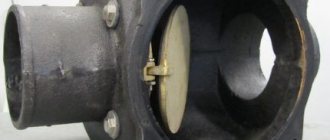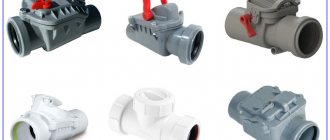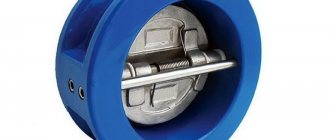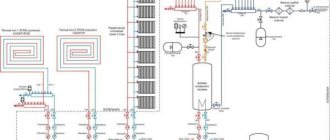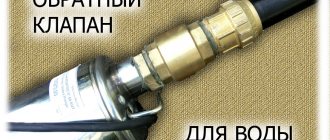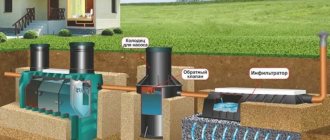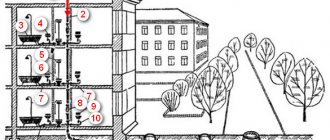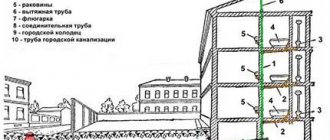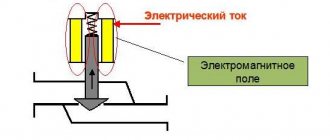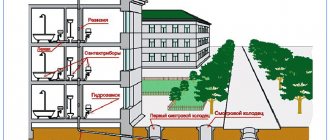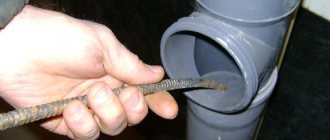SHARE ON SOCIAL NETWORKS
FacebookTwitterOkGoogle+PinterestVk
Every homeowner at least once in his life has encountered the consequences of a clogged sewer, which can occur as a result of a large foreign object getting into it, violations of operating conditions, or improper installation. This leads to the reverse flow of wastewater and its pouring out of the plumbing fixture. It is very easy to prevent such troubles. To do this, use a sewer check valve 110 mm or another size.
Non-return valves are used to protect buildings from floods and flooding of premises with wastewater from sewers
Possible causes of sewer blockage
The occurrence of fecal backflow can be caused by several reasons. The first lies in the improper operation of the sewer system, where plastic bags, intimate hygiene products and other things that block the cross-section of the pipe may unintentionally end up.
Non-return valves make it possible to freely drain wastewater when the level in the drainage channel drops
In this case, you will need to think about how to break through the sewer at home. The most effective method is to use a cable to clean pipes.
During long-term operation, deposits appear on the inner walls of pipes, which gradually grow, reducing the clearance of the pipeline. The settled sediment forms a rough surface on which solid particles accumulate, resulting in the formation of a plug. A good result for removing blockages is the use of chemicals that dissolve deposits inside the drain.
Another possible cause of clogging of the sewer system is an incorrect slope of the collector, which occurs as a result of improperly performed installation work. Here it should be understood that a traffic jam can form both with a strong and with an insufficient slope. To prevent solid contaminated particles from accumulating on the inner walls of the pipeline, water must move through it at a certain speed. This problem can be eliminated only by completely reworking the system.
During long-term operation, deposits appear on the inner walls of pipes, which gradually grow
A common cause of clogged sewer drains is the presence of a large number of outlets located at an angle of 90°. This configuration of the system contributes to a sharp change in the speed of movement of wastewater. Large suspensions can immediately linger, forming a plug.
The occurrence of blockages
List of reasons
- Wear and tear of sewer pipes (poor flow capacity)
- Ingress of large debris
- Residents doing renovations flush waste construction materials down the toilet.
What to do?
When there is a blockage in the sewer riser, the reason is no longer important. Apartments on the first two floors suffer. The sewer column rarely rises higher.
The speed at which our emergency services work is needless to say. By the time they get there, they will identify and eliminate the cause. The entire home may be filled with sewage. To put it mildly, this will cause discomfort.
It is generally accepted that the culprit is large debris, but in fact it only reduces the throughput, but subsequent discharges of sewage lead to the final blockage of the system, which is the reason for the rise of the column. As you know, water will always find a hole and the toilet will be the first one in its path.
According to the same scheme, a traffic jam is formed in an incorrectly designed and installed system. It is enough to disturb the angle of the pipe, and a quick blockage is guaranteed.
The old sewer system itself is potentially dangerous. She served her purpose a long time ago. The internal diameter of the pipes is greatly narrowed; a plastic bag is enough for an accident to occur.
In private homes, such overflows can be caused not only by disruption of the sewage system, but also by a sharply rising groundwater level.
What is a check valve for sewerage 110 mm and other sizes
A check valve is a type of shut-off valve. It is installed in the lumen of the pipeline to block the reverse flow of liquid in case of clogging of the system. The device is installed in the basement on a horizontal section of the general sewer at the junction of the pipes. It can also be installed at a 90º turn in the pipeline.
To achieve maximum safety, a 50 mm sewer check valve can also be mounted on branches to plumbing fixtures on the first and second floors of an apartment building. This enhanced measure is justified by the fact that fecal water, when flowing back, can only rise above the first floor. Further, the accumulated mass is able to independently push through the plug formed in the pipe.
The check valve can be installed where the pipeline turns 90º
For the private sector, a check valve is installed before discharge into the sewer well (for each house separately - on the inside of the foundation). Such a device is also intended for an autonomous system, where wastewater accumulates in a drainage pit or in a septic tank. In this case, you should worry about how to fill the sewer cover with your own hands.
The check valve is characterized by simplicity of design, reliability, efficiency, durability, easy installation and convenient maintenance.
Operating rules and common mistakes
- The aeration valve must be sealed. You can check it by simply filling it with water. There should be no leaks.
- The location of the aerator in the sewer network is strictly vertical. With a horizontal device, correct operation of the device is not guaranteed. The valve can be installed on a horizontal pipe section using adapters, but it itself has a vertical position.
- If necessary, access to the valve must always be open. It does not require regular maintenance, but must be easily accessible for cleaning and monitoring.
- During installation, it is necessary to take into account that air must flow freely to the aerator, since when a large amount of liquid is drained into the system, 25 times more air is entrained than the volume of water. The room should be well ventilated or have an exhaust hood.
- The aerator is installed at the highest point of the riser, above the connection level of the outermost drain point. For different connection options, different adapters, crosses, etc. are used.
- The valve installation can be hidden. To ensure that air flows well to it in this case, a ventilation hole is made in the pipe according to the size of the aerator mesh.
- Some models are used not only for air intake, but also for cleaning sewers. To do this, remove the valve cover, take out its mechanism and insert a metal cable inside.
The structure and principle of operation of a 110 mm sewer check valve
The check valve is compatible with all sewer pipelines of standard cross-section. Such safety fittings consist of a hexagonal housing, which can be made of metal or plastic. The internal space is conventionally divided into a receiving part with an inlet for connecting to the pipeline and a limiter in the form of a plate, which fixes the shut-off element and the outlet zone.
Important! The limiter is equipped with a sealing element that ensures maximum tightness when the valve is completely closed.
The check valve is characterized by simplicity of design, reliability, efficiency, durability
During normal fluid flow, the shut-off restrictor helps create full clearance in the pipe. If the water flows back, the shut-off element blocks it. Through the outlet zone, wastewater is discharged through the sewer line into the general system.
The operating principle of a 110 mm and other size sewer valve is as follows. At the moment the free movement of fecal matter stops, the pressure in the inlet and outlet zones of the valve is equalized. Under the influence of gravity, the limiter begins to block the gap in the pipe. This happens due to the expansion of the spring that is attached to it. In this position, it firmly holds the locking element. During normal operation of the system, the spring will be compressed.
Check valves are either mechanical or automatic. The operating principle of the devices is almost the same, except that the automatic device gives an alarm when an emergency occurs.
The check valve can be horizontal or vertical. The first option has become more widespread. A 110 mm vertical check valve is installed on the sewer system to automatically shut off the drainage system and to protect it in the event of a storm drain blockage. This element is used as a sewer inspection.
Check valves provide good protection against the penetration of unpleasant odors into the building.
Design of check valves for sewerage
Based on the design features of shut-off valves, a distinction is made between ball, rotary (petal), lift and wafer check valves. Despite the different designs of working areas, all types of devices have the same operating principle.
The ball check valve is equipped with a ball-shaped limiter. During normal operation of the system, the element is located in a special recess inside the housing, creating an open gap. As soon as the wastewater begins to move in the opposite direction, it blocks the cross-section of the pipe. This form of the locking element does not ensure the tightness of the valve as a result of the loose fit of the ball to the side walls. This may cause drainage to leak.
The wafer check valve has small dimensions. Its body looks like a hollow cylinder; inside there is a rotating bolt in the form of a small disk. It can be fixed on one side to the wall of the housing by means of a spring or have two flaps attached to a rod that passes through the center of the device.
The wafer check valve is small in size
Such a valve can be located on both horizontal and vertical sections of the pipe. When installing it, no additional gaskets are used, since the device is equipped with seals.
There are two types of 110 mm wafer check valve (and other sizes): disc and butterfly. In the first option, the locking element is made in the form of a solid disk fixed at the top of the body. Lowering under its own weight, it completely covers the cross-section of the pipe. This is the most reliable type of safety valve. However, it is used exclusively in a gravity system.
A double-leaf wafer valve has a central stem on which two petals are located. During the reverse movement of water, these flaps are pressed against each other by means of springs, blocking the cross-section of the pipe.
Features of Rotary Leaf and Lift Check Valve
In rotary reed valves, the working element is represented by a spring-loaded membrane resembling the shape of a round petal. When fecal matter flows freely through the sewer pipe, the plate is located in the upper part of the body in an inverted position, which does not interfere with the movement of liquid. If a reverse flow occurs, the membrane is pressed in the housing cavity against the rim, reliably and hermetically blocking the gap in the pipe. For inspection of the device, a removable cover is located in the upper part of the case.
The soft system is characterized by smooth movement of the petal locking mechanism
Important! There are check valves for a 110 mm pipe of the petal type with a manual shutter, which is a second plate, the operation of which is controlled using a button located on the body of the device.
Rotary valves can have a hard or soft system. In the first case, the disk covers the cross-section of the pipe under its own weight. This option is advisable to use for non-pressure systems with a small volume of wastewater. If it is installed on a pump or on a high-capacity network, the device can cause water hammer, which is a dangerous phenomenon for pipes. The soft system is characterized by smooth movement of the petal locking mechanism. In this case, water hammer is excluded.
The lift check valve has a shut-off element that is raised upward during normal operation of the system, which occurs due to the compression of the spring under the influence of gravity. When the liquid flows back, the spring expands and the lock closes the lumen of the pipe. This type of valve is more susceptible to clogging than others, which is due to the complex configuration of the body. It requires regular maintenance to function properly. This is the most common type of valve and is most often installed on the ground floor.
When fecal matter flows through the pipe, the plate is located in the upper part of the valve body in an inverted position
Criteria for selecting a check valve for sewerage
Before purchasing a check valve, you should decide where exactly the fittings will be installed. The standard size of the product is selected in accordance with the diameter of the sewer pipeline.
For the manufacture of shut-off valves, the same material is used as for the production of the manifold. Here you should also pay attention to the quality of the device. Preference is given to a durable product made from a material that is resistant to negative consequences.
The device can be made of plastic, cast iron, steel or bronze. Plastic products are currently very popular, due to the installation of a drainage system made of plastic or polypropylene pipes. Metal products are most often used for external pipelines.
Helpful advice! For indoor installation, a gray plastic check valve is used, and for outdoor installation, an orange one is used.
The valve size is selected based on the diameter of the sewer pipeline
Check valves come in different diameters. For indoor systems, devices with a cross section of 50 mm are used. A 110 mm check valve is installed on the outlet pipe from the toilet. For external systems, devices with a diameter of 150 mm or more are used.
Helpful advice! If the valve and pipeline have different diameters, special adapters will be required when installing the device.
The valve must have a simple design, which ensures its easy, quick installation and convenient maintenance. For this purpose, it is recommended to choose models with a removable cover, which can be removed to clean the locking mechanism.
Related article:
Non-return valve for sewerage: protecting your home from flooding with sewageOperating principle and purpose of the device. Types of locking devices. Rules for selecting and installing a check valve.
A 110 mm sewer check valve can have one or two dampers. The second option is more reliable, since it is possible to close the device manually. This is a guarantee of reliable and durable operation of the mechanism.
How to install a check valve on a sewer pipe
There are two ways to install a check valve in a sewer system. The first involves installing a shut-off element on a common sewer in an apartment building. In the second case, the device is installed for each drain source. This option is used for private households.
The sewer check valve can be installed in two ways
Helpful advice! According to experts, installing one check valve measuring 110 mm for one riser is insufficient protection against possible flooding with wastewater, so it is recommended to additionally install shut-off devices on the first floors.
When installing the locking mechanism, it should be remembered that the valve is not mounted on the sewer pipe into the drain gap under the inspection cover. The dampers can operate effectively in a horizontal system. Otherwise, problems will arise with the drainage of wastewater, since the membrane in this position will not create their unimpeded movement.
When choosing a place to install a check valve, it is necessary to take into account that the device must be easily accessible so that in the event of an accident you do not have to dismantle the decoration or move furniture. A 110 mm sewer check valve is installed in the basement after the rotary elbow - before the pipeline enters the wall. In an apartment, the device is placed on a cross or tee near the central drain into the riser. If there is no technical possibility, then you can attach one shut-off element with a diameter of 50 mm to the outlet towards the bathtub or kitchen, and install a second valve with a size of 110 mm on the toilet.
Installing a 110 mm check valve for one riser is insufficient protection against flooding
The shut-off valves are mounted in such a position that it is possible to ensure free movement of flow in one direction. A hint is the indicator on the valve body, which indicates the direction of flow. It is necessary that the valve is at least 100 mm from the highest siphon.
Important! The check valve must not withstand compressive, tensile or torsional loads from the connected pipes.
The size and material of the valve must match the characteristics of the pipeline. Otherwise, you will have to use adapters, which will weaken the reliability of the system.
Installation of 110 mm check valves made of different materials on the sewer system
Currently, as evidenced by reviews from owners, a 110 mm sewer check valve is most often chosen in a plastic version. This is due to the fact that the drainage system is mounted from this material. Installation of the product does not cause any difficulties.
Check valves for sewerage are most often made of plastic.
Once the location for installing the valve has been selected, a section of the pipeline should be cut, the length of which must match the dimensions of the shut-off device with an allowance of 5 cm. The pipe sections must be processed with a file. A valve with a socket connection is placed on a section of pipeline. The same procedure is performed on the exhaust manifold side. The connection is sealed using sealing elements of the locking device.
Helpful advice! To ensure the most reliable connection, the edges of the pipes are recommended to be treated with sealant before installation in the socket.
When using a plastic check valve for a 110 mm sewer pipe for a cast iron or steel pipe, you must additionally purchase two adapters. The sequence of work is the same as when installing a shut-off element on plastic pipes. Using a grinder, a space is cut out on the manifold for mounting the locking element. The edges are processed with a sanding machine.
An adapter is put on a piece of pipe, then a check valve, after that another adapter, which is attached at the other end to the pipe by means of a socket connection using tow. To make the system reliable, the seams are treated with silicone.
Check valves can be made of cast iron and steel
Important! The cast iron check valve is mounted using bolted joints by tightening the mounting plates and sealing rubber bands.
The valve installation method allows us to distinguish the following designs:
- Flanged . Suitable for connection to large cross-section pipes that have a similar fastening element. The valve with flanges is conveniently mounted on pipeline sections with a vertical or horizontal arrangement.
- Bell- shaped The valve with a conical socket and a rubber sealing ring easily mates with other pipeline elements.
- Couplings . The products are designed to mate with pipes (mostly metal) of small diameters - up to 2.5 inches.
Flanged and Union Check Valve
The material for the manufacture of check valves is:
- Stainless steel . Used for the production of interflange products. Other types of valves can also be manufactured for inclusion in a metal pipe system. In products made from other materials, stainless steel dampers can be used.
- Polyvinyl chloride (PVC) . The most common material for large cross-section sewer valve bodies.
- Polypropylene . The sewer check valve 110-315 mm polypropylene remains operational at +95°C without deformation. The housing material includes components that can partially suppress the operating noise of the product.
- ABS plastic . This thermoplastic resin produces durable and impact-resistant housings for check valves.
- Cast iron . Such designs are recommended for installation in loaded systems (usually external) made of large-section cast iron pipes.
Why is a 110mm air check valve used?
To eliminate the possibility of wastewater entering the room, an air valve is mounted on the drain pipe, which allows air into the system and prevents it from coming out back. Such a shut-off element also helps to reduce the noise level in the system when the waste stream moves.
When water is drained, a vacuum occurs in the sewer system, causing air to enter it. This is accomplished due to the presence of ventilation or plumbing fixtures that have the smallest water seal. As a result of the vacuum, the membrane opens, and after the pressure stabilizes, it closes, which prevents the flow of air back into the room.
The air check valve for sewerage is made of high quality plastic. The element consists of a body, a membrane or rod, a rubber seal and a cover. The membrane reacts to excess pressure in the network and is activated when it occurs. The operating mode of the rod is controlled by the sealing gasket. The element is connected to the pipeline through a side hole.
Fan valve 110 mm is fixed only in a vertical position
A 110 mm vent valve for sewerage, like a return valve, is installed no higher than the 2nd floor. It should be located above the largest sewer pipe connected to the device. The valve is fixed in a vertical position. It is mounted to the pipeline using a socket connection, complete sealing of which is ensured using rubber cuffs treated with silicone.
Important! The air valve is installed in a place where the temperature will not drop below 0 °C.
The locking element can be automatic, anti-vacuum or a combination. The first type of product has a low throughput. The second valve option works well at low pressure. The combined version combines the features of both types of devices.
Determining the installation location
It is important to know! The air valve for sewerage is usually mounted 20-30 cm above the main pipe. During installation work, do not allow dust, dirt or liquid to penetrate the membrane. For optimal performance, a systematic supply of oxygen is necessary.
For installation in an apartment, the device is mounted on a pipeline in a vertical position. This method will not provide ventilation to the riser, but will eliminate odors in a specific area.
It is recommended to install a sewer air valve in a private house. In this case, it is possible not to carry the fan structure through the roof. But some experts argue that it should be mounted only as an auxiliary part to the riser.
In private houses and apartments, plastic sewers are installed. Air elements are also made from polypropylene or PVC.
The valve must be installed:
- In high-rise buildings that are connected to wastewater treatment plants.
- In waste disposal areas.
- When connecting sewerage to sanitary facilities.
- In systems that can be connected horizontally.
